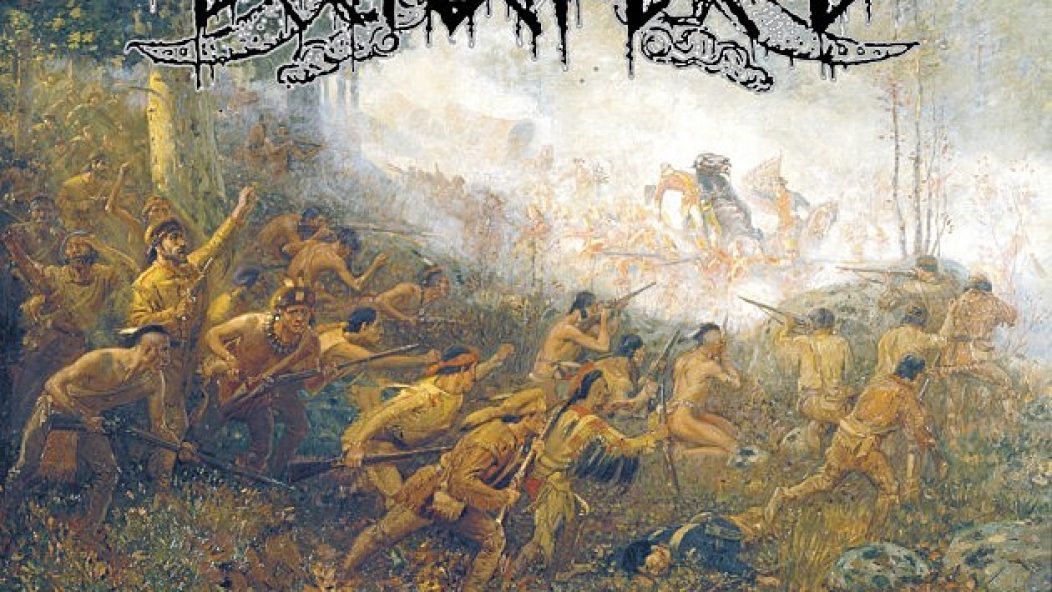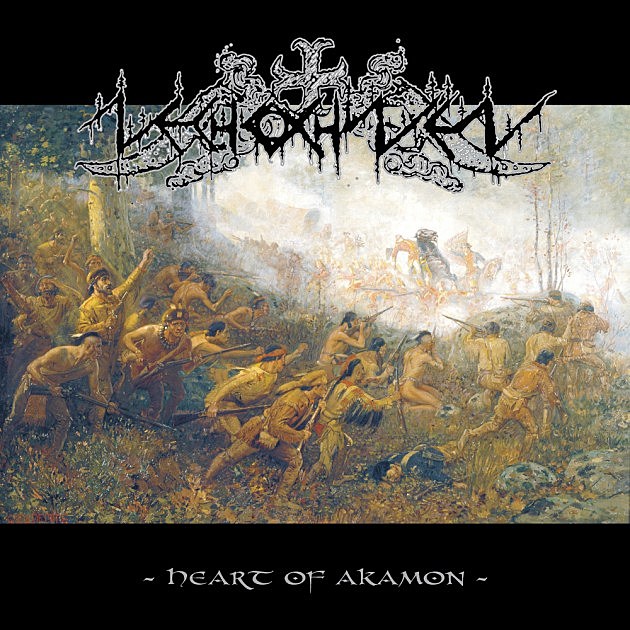
Top Albums of 2015, by Greg Majewski
…
I honestly can’t remember a more back-loaded year for me than 2015. I spent the majority of the year deliberating between a few would-be contenders, only to have autumn smack me across the face with one great album after another. To whit: my top three albums all came out between September and November. And sure, the usual suspects are here, with three bands on this list having made appearances on my 2013 and 2014 lists—A Pregnant Light alone claims the hat trick by making all three. What we can draw from this is that bands are not only turning out consistently fantastic work, but they’re doing it on a tighter timeline than we’re used to. Horrendous’ turnaround from Ecdysis to Anareta was almost exactly a year, and somehow Anareta is an improvement on its predecessor in every respect. It’s like the ‘70s again with Sabbath cranking out five classics in less than four years. It’s unbelievable. We’re truly in the middle of a new renaissance for heavy music, in both quality and sheer, suffocating quantity. And don’t even get me started on what Austin Lunn is accomplishing with Panopticon. It’s… well, read on and find out…
…

10. Archivist – Archivist (Alerta Antifascista, UK, Denmark, Austria)
Two things are certain when Alex Bradshaw’s name appears in a lineup: 1. Songs are gonna be long. 2. Shit’s about to get conceptual. This is the guy who penned a trilogy around Watership Down with Fall of Efrafa, then proceeded to tackle Paradise Lost and His Dark Materials with Light Bearer; he’s not afraid to commit to a story. This time, humanity has been brought to near extinction by machines in a pseudo-Matrix war, with a few thousand of our best minds escaping the planet in cryosleep to land somewhere else and begin anew. Except disaster strikes and all are lost save for a girl who stowed away on one of the ships after following her father onboard. What follows is a tale of literally the last conscious human alive as she forges a friendship with a machine onboard and begins the task of documenting all of our collected knowledge. Archivist tell this story through a bracing mix of post-rock and black metal not unlike a certain band from the Bay Area who also released an album this year. They just pull off the blend effortlessly — and better.
…

9. Obsequiae – Aria of Vernal Tombs (20 Buck Spin, USA)
The cover for Obsequiae’s debut Suspended in the Brume of Eos could not have been more appropriate: a dense medieval tapestry, dominated by rich blues, accented with scattered gold leaf. Obsequiae’s music is the aural equivalent, their intricate guitar lines dancing gracefully around each other, flitting from traditional modes to sharp, biting guitar lines. They’re the only band on the death metal spectrum I would dare to call “delicate.” On Aria of Vernal Tombs, Obsequiae went full bore and hired Vicente La Camera Marino, a real-deal medieval harpist. Marino’s resonant strings float over, through and around Tanner Anderson’s guitars, creating the best kind of sonic anachronism. After all, aren’t black metal rasps and distortion a more fitting requiem for the harshness of the Middle Ages than frilly minstrel ditties?
…

8. Caïna – Setter of Unseen Snares (Broken Limbs Recordings, UK)
Andrew Curtis-Brignell has wrestled with many topics in his decade-long tenure as the head of Caïna, but he’s never written a full-on concept album. Taking inspiration from Cormac McCarthy’s paternal doomsday text The Road, Setter of Unseen Snares details one family’s struggle to cope with the impeding end of world, this time in the form of an asteroid on a collision course with Earth. Humanity is doomed, but true to Curtis-Brignell’s past work, this is a personal story. Lives are weighed, sacrifices are made; penance, death, redemption is granted in equal measure. Setter would’ve earned a place on this list for “Orphan” alone, a 15-minute miniature masterpiece that encompasses the LP’s entire B side. It’s an emotionally exhausting, mood-shifting journey that justifies all that’s come before it: a side A that starts with a True Detective sample and blasts through four volleys of raw, punk-inflected black metal in 15 minutes. Much like McCarthy’s nihilism, there is no tidy ending here, no hint of any salvation. Rust Cohle says it best on “Introduction”: “I think the honourable thing for our species to do is to deny our programming. Stop reproducing, walk hand in hand into extinction. One last midnight, brothers and sisters opting out of a raw deal.”
…

7. Horrendous – Anareta (Dark Descent, USA)
How did they do it? How did Horrendous produce a sequel to one of 2014’s finest death metal albums so quickly? Not only that, how did they make it better? Did they melt down their Individual Thought Patterns, Symbolic and Testimony of the Ancients LPs and inject the resulting sludge straight into their bloodstreams? The songwriting in Anareta is on a level of sophistication rarely matched in modern death metal. In a way, it’s the spiritual successor to one of 2014’s other great DM records, Morbus Chron’s (R.I.P.) swansong, Sweven. Like that masterpiece, Anareta subverts expectations at every turn. At only three abums in, Horrendous’ ear for melody is so refined you don’t know you’re listening to an anthem until it’s all around you. They craft big ticket hooks (the magnificent chorus on “Ozymandias” and the steadily arching end to “Acolytes”) out of subtly complex melodies, tempering their considerable technical prowess with deft compositional choices that would be impressive for a band twice their age. Listen to the restraint on “Stillborn Gods”’ booming, open chord refrain and tell me these guys couldn’t pack an arena like ’87 Metallica if given the chance.
…

6. A Pregnant Light – All Saint’s Day (Colloquial Sound Recordings, USA)
Damian Master might as well set up permanent residency on all my future year-end lists from now until he decides to stop making music as A Pregnant Light. There are certain artists whose work affects you on an indefinable, profound level. From the my first playthrough of Domination Harmony back in 2013, I knew I wanted to hear everything this person introduced to the world, and I haven’t been disappointed since. It’s been a relatively quiet year for APL after Master dropped his first full-length in fall 2014. We’ve had a scattered EP and single that both felt like extensions of My Game Doesn’t Have a Name, but All Saint’s Day is something else. At only four songs, it somehow still manages to construct its own self-contained universe, displaying Master’s, um, mastery of what amounts to the aural equivalent of flash fiction. “Fear of God” rides a wave of black metal swells that crash and flood “Phoneix Street”’s lurid creation rhythm, pushing, pulling, pulsing with mounting layers of tremolo as Master climbs the heights he climbs so often. A ringing climax, a brief reprise and a harmonious culmination of every melody Master’s introduced in the preceding nine minutes: all in a day’s work.
…

5. Tribulation – The Children of the Night (Century Media, Sweden)
Is there any act in metal who’s had a more fascinating three-album arc than Tribulation? After channeling OSDM on 2009 debut The Horror, the quartet set sail for stranger waters with 2013’s Zappa-meets-Swedeath The Formulas of Death. It was a wake-up call to anyone who slept on their occasionally derivative debut, a clue that maybe greatness was just around the corner. Next thing you know, members are rocking bellbottoms, Jakob Ljungberg is leaning into every backbeat like it’s the mid-‘70s, and the band drops this catchy-as-all-hell third LP. In many ways, The Children of the Night is what Watain’s The Wild Hunt attempted to be: a widescreen, arena-ready rock record disguised as extreme metal. Take away the vocals and some of these songs would fit right in on your dad’s gym playlist, so mighty is the half-time groove of the chorus in“Winds,” or the glorious solo during “In the Dreams of the Dead.” Tribulation are at a point in their career where calling them death metal is no longer accurate, but there’s still enough darkness and grit here to keep them just outside the average listener’s spectrum. One clever YouTuber dubbed Children “goth ‘n’ roll,” a sly nod at mid-‘90s Entombed, who also threatened to crossover. If the power rock hook on “The Motherhood of God” is any indication (“Blessed be the hands whose touch is fire/Blessed be a death that takes you higher,” Johannes Anderson croaks with Freddie Mercury-gone-hoarse bravado), that shift could be anytime in the next two years.
…

4. Elder – Lore (Armageddon Shop, USA)
Elder belong to an elite cadre of bands who can make a 15-minute song fly by in half the time. The Boston power trio (yes, guitarist Mike DiSalvo is an animal) cram so many moving parts into one composition you’ll lose track of time and maybe even reality. Case in point, Lore’s winding, masterful title track. It’s the centerpiece on the five-song album and shows the band somehow wielding psychedelic leadwork, big-time sludge riffery and Southern rock swagger with equal proficiency. During the torrent of praise poured on Lore after its February release, I noticed most press about the album describing it as some strain of stoner/doom, which certainly applies to Elder’s penchant for giant riffs (the one that hits at 5:00 on “Lore” chief among them). But I hear more ‘70s prog in their sound now. Their ability to constantly keep such lengthy songs developing – always shifting some element of the composition whether it be in the fore- or background – is more glory days Yes than early ‘00s Relapse. And they can still psych out with the likes of Earthless, as heard on (you guessed it) “Lore”’s extended ambient break that not only comes in the middle of the song, but in the exact center of the entire album. And when those drums jump back in, subtly at first and then with ever-increasing urgency until the song explodes into majestic, layered arpeggios? Truly next-level. Those are three different movements in one song that flow effortlessly from one to the other, and that’s without even mentioning the gigantic fuzzed-out riff that caps off the song. That should tell you all you need to know.
…

3. Nechochwen – Heart of Akamon (Bindrune, USA)
For a genre with such a rich history of embracing the indigenous sounds of its bands’ respective countries of origin, it’s a wonder so few black metal bands in America have taken influence from our deepest musical tradition. Sure, Fall of Rauros and Panopticon have blended Americana and bluegrass, respectively, among the tumult and clamor. But we’re talking about our oldest music – the music played by the native peoples of this continent. West Virginia’s Nechochwen have been doing just that since 2008, emerging with ever-evolving and maturing attempts to seamlessly stitch together the clashing elements of Native American folk and what amounts to a very melodic strain of black metal. Heart of Akamon is their smoothest effort so far, straying from the split acoustic/metal halves of 2012 EP OtO and instead attempting to merge the two in each song. The album itself is about war and the loss resulting from it, a theme from which they ply both aggression (the furious blasting on “Lost On the Trail of the Setting Sun”) and sorrow (the aching lament “October 6, 1813”) with equal measure. But even on the “metal” songs, guitarist and founder Aaron Carey works in both of his disciplines; the fleet-fingered classical guitar picking during the break on “The Serpent Tradition” will get any Opeth fans hyped, and the chiming, lead-heavy “Skyhook” reaches blackgaze heights before a stunning nylon string duet. This is the first album on which Nechochwen make peace between their divergent sensbilities, and it’s all the better for it.
…

2. Panopticon – Autumn Eternal (Bindrune, USA)
There is perhaps no independent artist living the American dream better than Austin Lunn. Loving husband and father; career brewer; fiercely DIY metal musician; Lunn wears many hats and folds his extracurricular experiences in with his stampeding take on black metal as Panopticon. Through his day job he is able to finance his passion project and create art on his own terms, and what fine art it is. Lunn has been on a tear since 2012, dropping two critically acclaimed LPs and a number of splits, all of which culminated in Autumn Eternal. The final chapter of the trilogy Lunn began with black-metal-as-protest-music Kentucky and last year’s introspective Roads to the North, Autumn Eternal is Lunn’s most complete work to date, not too mention his most concise. You see, while stupendously proficient at nearly every instrument he gets his hands on, Lunn had a tendency to overplay on albums past. It’s hard to blame him; if I could play drums like that, I’d blast ‘till my arms fell off. But he curbed that habit on Autumn, pulling back just enough to let the songs breathe. The ambient sections that became somewhat predictable halfway markers in songs on past efforts are mostly used as transitions here, specifically on the seamless three-song suite of “Into the North Woods,” “Autumn Eternal” and “Oaks Ablaze.” It’s the most concise 21-minutes of music Lunn’s written so far, densely packed with emotion and wonder—the lead on “Into the North Woods” will make you weep if you’re not careful. Autumn Eternal still breaks the hour-mark, but its arrangements and sequencing will make it the most immediately replayable album in Lunn’s discography.
…

1. Magic Circle – Journey Blind (20 Buck Spin, US)
I already spent most of the word count in my review heaping praise on Journey Blind, but here’s maybe the best example of how hard this album hit me: before even my first playthrough of the promo, I knew it would be my album of the year. Hell, the competition may have been over before the first song was done. How can you argue with that riff!? Magic Circle could have easily fallen into the trap of front-loading an album with a killer track or two and then losing steam, but their songwriting abilities are too sharp for that. The key to Journey Blind is economy. In their riffs, arrangements and sequencing Magic Circle demonstrate a frankly staggering ability to never draw out a sequence for too long, always moving the composition forward even when they’re trudging through the mausoleum muck on a song like “A Ballad for the Vultures.” Just when you think you know a song, they kick into another gear. And the placement of biker rock anthem “Lightning Cage” right after? Perfect. And the riffs and arrangements on Journey Blind are so memorable it takes a few listens to realize just how emotive Brendan Radigan is as a vocalist. During “Ballad”s second-half explosion, he wails “Death again/And live until the end” in a pitch so perfect you’ll blow out your own voice trying to match it. More than doom, this is truly empowering stuff. Back before we sub-categorized everything as “power” this or “trad” that, there existed a genre simply called “heavy metal.” You could hop in a time machine with an LP of Journey Blind and head to any decade as far back as the ‘70s, and it would be as vital and relevant as it is in 2015; it’s the very definition of timeless. And perhaps that is the highest praise I can bestow.
…
Non-metal album of the year:
Superhumanoids – Do You Feel OK? (Innovative Leisure, USA)
The third track on Do You Feel OK? is called “Norwegian Black Metal.” That’s about the only thing this has in common with anything in the heavy realm (it’s also probably the best music video of the year). In a year when Chvrches dropped their much-hyped sophomore LP, Los Angeles’ Superhumanoids came away with the most impressive synthpop album of 2015. Absent of cloying hooks or faux aloofness, this is 11 songs of clever arrangements and subtle earworms. Superhumanoids make the emotional distance and self-doubt of the Instagram generation irresistibly catchy while lacing the proceedings with a markedly Scandinavian sense of melancholy. Sarah Chernoff’s whisper-coo of “Everything implies that we’re all going to die/Go digital white noise doldrums swallow whole” is as frigid as an Immortal album cover.
…
Album I missed in 2014:
Lotus Thief – Rervm (Svart, US)
I heard Rervm the same week I turned in my 2014 year-end list and regretted not checking it out earlier about halfway through my first spin. Big, riffy psych metal songs bookended by extended ambience and found sounds. I’ve been on a mission to find anything else bandleader Bezaelith has lent her stunning voice to, but so far no such luck.
…











